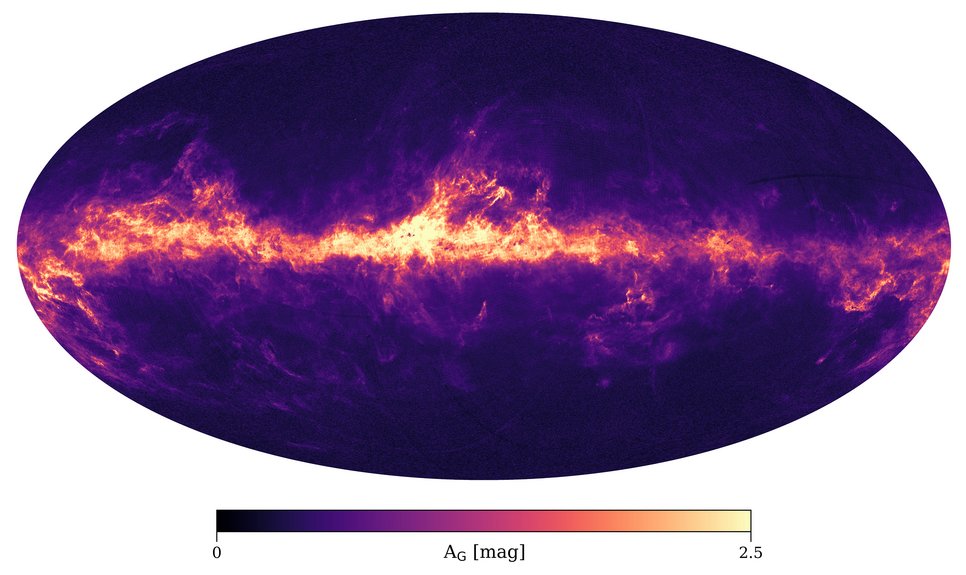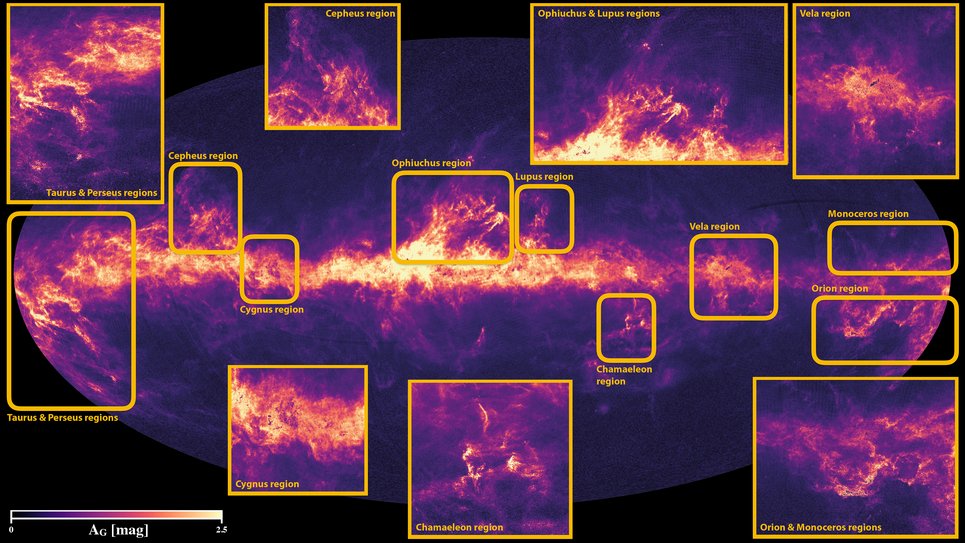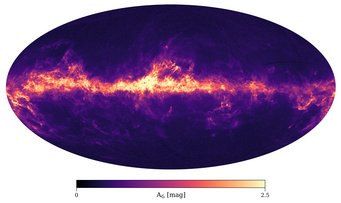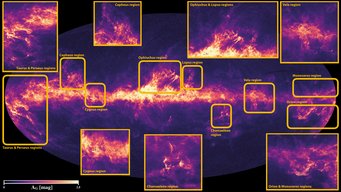Gaia data release provides most complete census of stars yet, draws dust map of Milky Way
The new data release of ESA’s Gaia satellite, published today, not only includes data that allows astronomers to compute accurate distances for 1.33 billion stars. Researchers based at the Max Planck Institute for Astronomy have also used Gaia’s measurements to derive the physical properties of almost 80 million stars, making this the largest stellar census yet. At the same time, the analysis provides the most detailed three-dimensional map of dust in our home galaxy yet, which promises to put the analysis of celestial objects on a more solid footing than before.
| Background information | Download area |

ESA’s Gaia satellite is first and foremost an astrometry satellite: using simple geometry (namely the parallax method) and highly accurate stellar position measurements, the satellite has collected data that allows astronomers to determine the distances and stellar motions for 1.33 billion stars, and thus to map our cosmic neighborhood with breathtaking precision. Determining such distances is essential for understanding the physical properties of astronomical objects – after all, an object with a given observed brightness could be rather dim, but comparatively near, or emit lots of light but be very far away. Without distance measurements, we cannot tell which. Almost all astronomical distance measurements depend on the kind of geometric measurement provided by Gaia. With its high-precision data, Gaia securely “anchors” distance measurements throughout astronomy.
But in addition to measuring stellar positions with high precision, Gaia also provides precise brightness measurements for three different wavelength bands (corresponding to three different colors called G broad-band, BP and RP band) for 1.38 billion sources. These measurements provide valuable clues as to the astrophysical properties of the objects in question. This is where the data analysis group CU8 comes in, which is managed by Coryn Bailer-Jones of the Max Planck Institute for Astronomy and part of Gaia’s Data Processing and Analysis Consortium (DPAC).

Bailer-Jones and his colleagues are experts in deriving astrophysical quantities from the Gaia data. From the brightness measurements, they were able to estimate the effective temperature for 161 million stars among those observed by Gaia, and derive the luminosity (that is, the amount of energy emitted per unit time) and the radius for 77 millions of those stars. This is the largest uniformly derived set of physical properties to date. The results were included as part of the new Gaia data release DR2.
The astronomers also extracted information about the dust content of our cosmic neighborhood from their analysis. The space between stars is not empty but rather filled with dust and gas clouds. When starlight travels through a dust cloud, some of the light is scattered, and thus when we observe the star through a dust cloud, it appears a little dimmer than without the dust, an effect known as extinction. For light at different wavelengths – different colors – the effect varies: light at shorter wavelengths (towards the blue end of the spectrum) is scattered more strongly than at longer wavelengths (red end of the spectrum). This characteristic wavelengths-dependence allows astronomers to reconstruct the extent of the extinction starlight has undergone.
For 88 million stars, the astronomers determined the extinction along with the star’s physical properties. A map of these extinction values can be seen in the image included with this release. Combined with these stars’ three-dimensional positions, which are known from Gaia’s astrometric measurements, the extinction values towards these stars are sufficient data to construct a three-dimensional map of dust distribution within our galaxy.
On the far left side of the map are the Taurus and Perseus cloud complexes. On the right side of the map is the Orion molecular cloud complex, a small part of which can be seen with the naked eye as the Orion nebula. This cloud, the California nebula in the constellation Perseus and the Ophiuchus cloud complex just above the Galactic center show exquisite substructures.
The extinctionderived from the Gaia data will allow astronomers to reconstruct the three-dimensional dust density of the Milky Way, gaining key insight into the distribution of the interstellar medium – the gas and dust between the stars. The interstellar medium is the stuff out of which stars are born. Stars, in turn, heat up the interstellar medium when they die, and seed it with the chemical elements they have produced via nuclear fusion over the course of their lives.
The dust in the interstellar medium absorbs light at short wavelengths (UV), scattering and re-emitting it at long wavelengths (IR). Dust shields molecules from destruction. This is crucial for the formation of planets and for what kind of molecules end up as part of newly forming planets. Studying the properties of dust, such as its three-dimensional distribution and variations in density, is crucial to understanding the physics of this balance. It provides us with important clues to the physical mechanisms of the formation of stars and of galaxies, and to the history of our home galaxy. In Heidelberg, these clues will find fertile ground – the city hosts a collaborative research center funded by Deutsche Forschungsgemeinschaft, SFB 881 “The Milky Way System”, dedicated to research on our home galaxy.
All in all, the new Gaia data is a treasure trove of information about our home galaxy, and will influence astronomy for years to come.
Background information
The results described here were published in Andrae et al. 2018, “Gaia Data Release 2: first stellar parameters from Apsis'' in the journal Astronomy & Astrophysics.
The work is based on data from the European Space Agency (ESA) mission Gaia, processed by the GaiaData Processing and Analysis Consortium (DPAC). Funding for the DPAC has been provided by national institutions, in particular the institutions participating in the Gaia Multilateral Agreement. Funding specifically for the DPAC work in this paper has been provided by the DLR (German space agency) via grants 50 QG 0602, 50 QG 1001, and 50 QG 1403.
The MPIA researchers involved were Coryn A.L. Bailer-Jones, René Andrae and Morgan Fouesneau
in collaboration with
Orlagh Creevey, Christophe Ordenovic, Georges Kordopatis, Bernard Pichon, Frederic Thévenin (Université Côte d'Azur, Observatoire de la Côte d'Azur/OCA), Andreas Korn (Uppsala University), Yveline Lebreton (LESIA, Observatoire de Paris), Nicolas Mary, Alexandru Burlacu, Laurence Chaoul, Anne Jean-Antoine-Piccolo, Chantal Panem and
Gavin Walmsley (Centre National d'Etudes Spatiales/CNES).
Links
Additional figures and download

Figure 1


